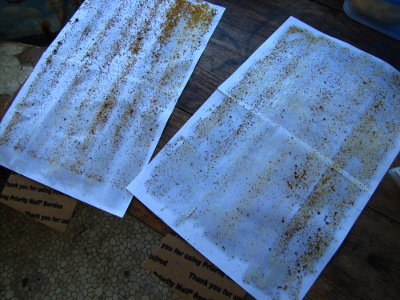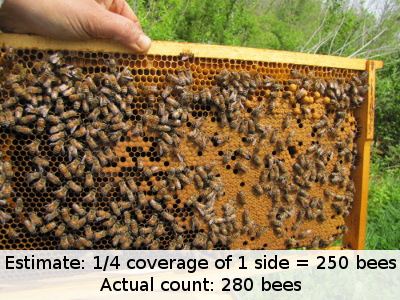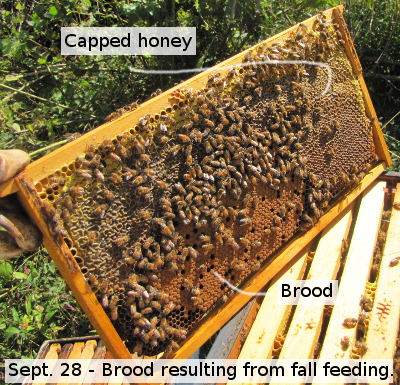
Calculating varroa mites per thousand bees
 If you want to monitor the
varroa mite levels in your bee hives, it's a good idea to take counts
at multiple times rather than using one snapshot to assess the long
term health of your hive. So I repeated my three
day stickyboard counts
this week. To refresh your memories, the
mother hive dropped 44 varroa mites per day in mid September while the
daughter hive dropped 12 per day.
If you want to monitor the
varroa mite levels in your bee hives, it's a good idea to take counts
at multiple times rather than using one snapshot to assess the long
term health of your hive. So I repeated my three
day stickyboard counts
this week. To refresh your memories, the
mother hive dropped 44 varroa mites per day in mid September while the
daughter hive dropped 12 per day.
My new count showed
nearly the same mite fall for the mother hive --- 41 mites per day ---
but it seemed like the varroa mite population in the daughter have had
undergone a population explosion. This time, the daughter hive
dropped 200 total mites, or 67 per day!
An increasing varroa
mite population in the autumn is bad news, but I decided to get a bit
more scientific before I started to worry. Mite fall is a
problematic way to monitor varroa mites since a large population of
bees will naturally drop many more mites than a small population of
bees. The way to deal with this error is to estimate how many
bees are currently in your hive and calculate mite fall per thousand
bees per day.
 No, I didn't sit in front of
the hive and count heads all day long. Instead, I looked through
both hives, counting how many frames (or portions of frames) were
covered with bees. A deep frame completely covered with bees on
both sides holds roughly 2,000 workers, so I was able to come up with
population estimates for both hives.
No, I didn't sit in front of
the hive and count heads all day long. Instead, I looked through
both hives, counting how many frames (or portions of frames) were
covered with bees. A deep frame completely covered with bees on
both sides holds roughly 2,000 workers, so I was able to come up with
population estimates for both hives.
Remember how I started feeding
the daughter hive a
few weeks ago since I was concerned that she was going into winter with
too few honey stores? One of the troubles with fall feeding is
that it can prompt the queen to lay lots of eggs at a time of year when
the hive doesn't need that many workers. The mother hive --- not
fed, so changing her population based on the natural ebb of the seasons
--- had roughly 9,500 bees in the hive. On the other hand, the
daughter hive had bulked up drastically and now housed 18,250 bees!
 The good news is that when
you divide the mite fall figures by the population of each hive, it
turns out that the daughter hive is in fine shape. The mother had
roughly 4.3 varroa mites fall per thousand bees per day during my test
while the daughter had 3.7 mites per thousand bees per day. Given
all of the wiggle room in my measurements, I'd say mite populations in
each hive are roughly equal on a per bee basis.
The good news is that when
you divide the mite fall figures by the population of each hive, it
turns out that the daughter hive is in fine shape. The mother had
roughly 4.3 varroa mites fall per thousand bees per day during my test
while the daughter had 3.7 mites per thousand bees per day. Given
all of the wiggle room in my measurements, I'd say mite populations in
each hive are roughly equal on a per bee basis.
The bad news is that the
daughter hive has way too many workers in it! She has put away
the 22 pounds of sugar I gave her and now has 48 pounds of capped
honey, but I'm a little concerned that the massive population of
workers will eat right through it before winter comes. Hopefully
once the unnatural "nectar flow" disappears, the hive will kick out
those extra workers ASAP.
Want more in-depth information? Browse through our books.
Or explore more posts by date or by subject.
About us: Anna Hess and Mark Hamilton spent over a decade living self-sufficiently in the mountains of Virginia before moving north to start over from scratch in the foothills of Ohio. They've experimented with permaculture, no-till gardening, trailersteading, home-based microbusinesses and much more, writing about their adventures in both blogs and books.
Want to be notified when new comments are posted on this page? Click on the RSS button after you add a comment to subscribe to the comment feed, or simply check the box beside "email replies to me" while writing your comment.

Good info, as always.
I'm curious to how you would have treated for varroa if you had discovered that the hives were overrun with varroa.